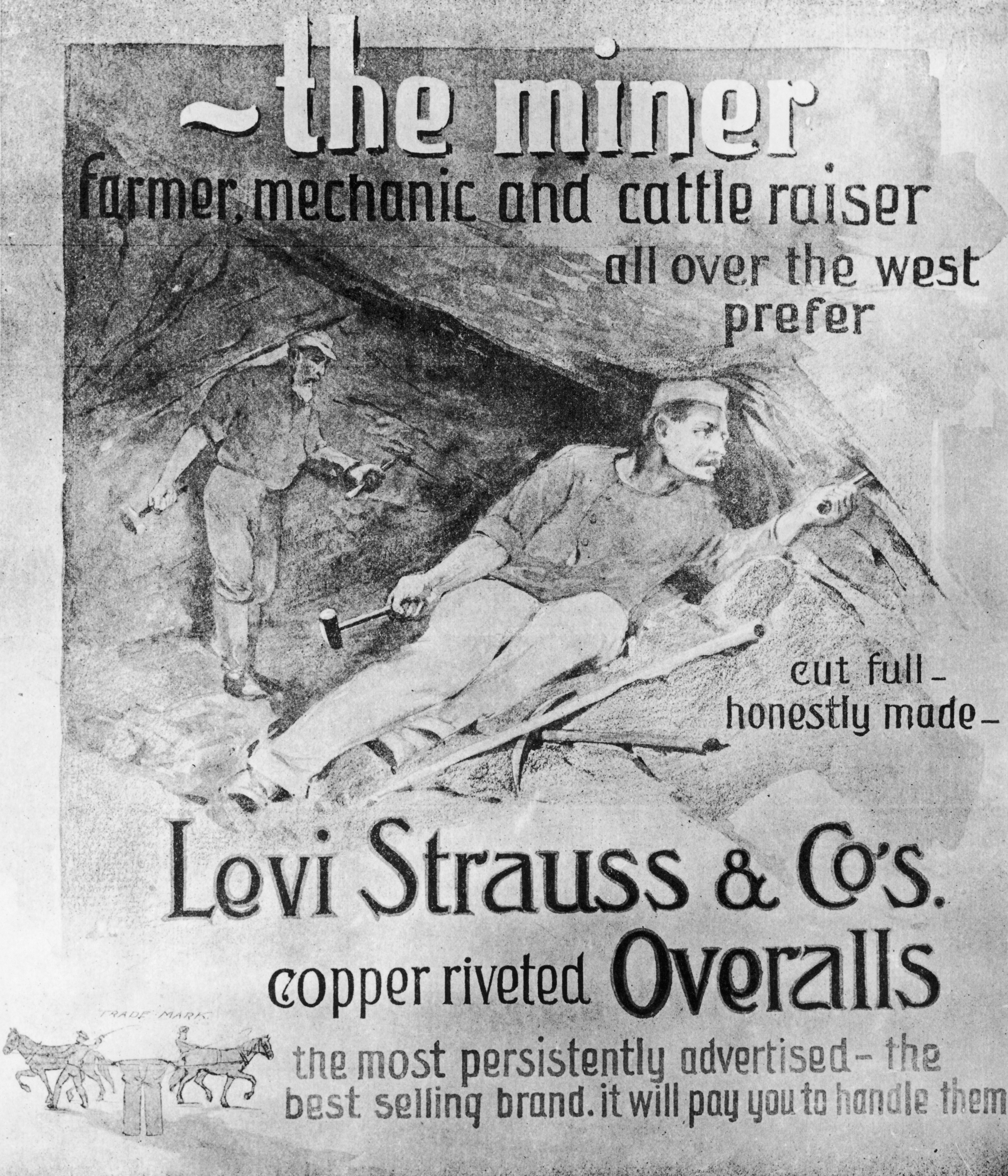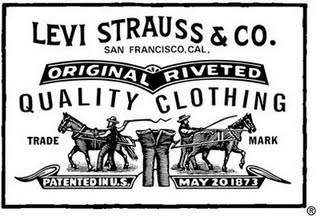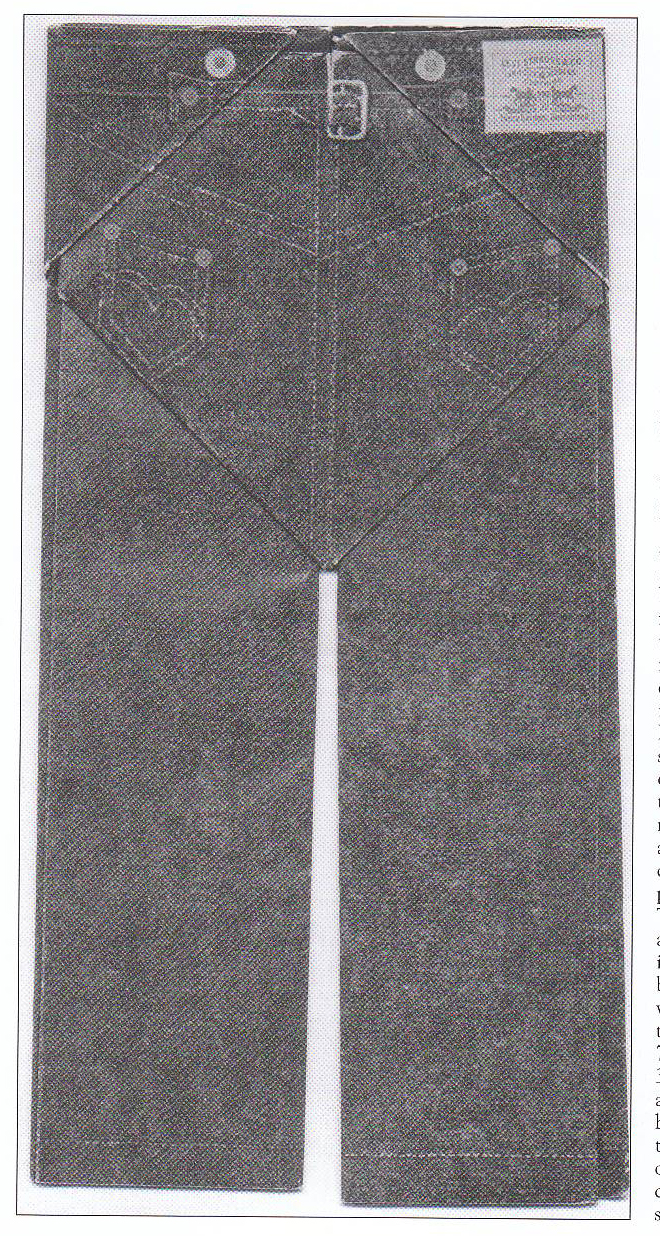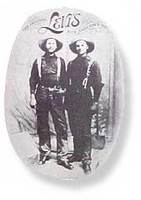The Blue Jeans Are Born
____________________________________________ . ____________________________________________
When 24-year-old Levi Strauss finally opened his dry goods wholesale bussiness as Levi Strauss & Co. in San Francisco, a customer of his asked him if he had brought any pants with him from New York since he couldn't find a pair of long lasting pants. Sadly, Levi only had with him some rough canvas and wagon covers. As a result, Levi Strauss had the canvas made into waist overalls. The waist overalls were perfect for the miners during the California Gold Rush but many of them complained that when they began to rub on the overalls, their skins would go sore (CHAFE=PROPER WORD). Thus, Levi subsituted a twilled cotton fabric from France called "serge de Nimes" which later became known as denim. Over time, the pants were nicknamed "blue jeans."
________________________________________________.____________________________________________________ |  This is an advertisment for Levi Strauss & Co.'s new copper riveted waist overalls. Citation: http://www.gettyimages.com/detail/76937661/Hulton-Archive |
In 1872, Levi Strauss received a letter from Jacob Davis whom was a tailor who was making riveted clothing for miners in the Nevada area. Jacob Davis needed money to file for a patent and offered Levi a deal if he was willing to help support him in this. Mr. Strauss obviously said yes and he began to make copper-riveted "waist overalls." As waist overalls became more popular in the West, the Pacific Rural Press noticed that these work pants were amazingly durable and strong and good for the miners. On June 28th, 1873 the Pacific Rural Press saw that "Nothing looks more slouchy in a workman than to see his pockets ripped open and hanging down, and no other part of the clothing is so apt to be torn and ripped as the pockets." In 1886, the Levi's "Two Horse Brand" leather patch was first used. The image on the patch was a pair of jeans being pulled by two strong horses; this was supposed to symbolize the strength of Levis Jeans.
|  This is one of Levi Strauss' Guarantee Labels. Citation: http://www.industryplayer.com/images/licrespic/Label-two-horses.png |
 This is a pair of Koveralls, jeans designed especially for children. Citation: "Levi Strauss & Co." Downey, Lynn (pg.34)
Just like Levi Strauss, Jacob Davis was also an immigrant who came to the U.S. and then to San Francisco. He served as a tailor who often came by Levi Strauss's shop to purchase white duck cloth to make fabric wagon covers and tents for his tailor shop. In around the late 1870s, Jacob Davis finally got the idea of using copper rivets to add strength for one of his customer's worn out work pants since he thought that the thread alone didn't help support the pockets enough onto the work pants. As a result, by 1871, Jacob Davis started using rivets on the pants he created; first on duck fabric and then to denim. Because the other businesses were constantly stealing his bright idea, Davis decided to call Levi Strauss to help him financially with applying for a patent and he agreed to help. Thereafter, when the patent was finally accepted on May 20, 1873 "waist overalls" became the first traditional jean name. | ______________________________________.__________________________________________ In May 20, 1873 the first riveted clothing, patent #139,121, was issued to the Levi Strauss & Co, making them the first to manufacture blue denim jeans. The truth was, Levi Strauss was not the only creator behind this; Jacob Davis played an important role as well. Jacob Davis came up with the idea of adding rivets to denim pants, while Levi Strauss paid for the patent on jeans and produced them.
 This advertisment is for Lady Levi's, the line of jeans designed for women. Citation: http://www.apparelnews.net/image/barajas/levis2.JPG |
____________________________________________________________________________._____________________________________________________________________________
By 1875, Levi had purchased the Mission and Pacific Woolen Mills from the estate of William Ralston. The denim was bought from Amoskeag Mill. The word about the jeans’ durability spread quickly and became a popular garment for industrial workers. They found the pants so comfortable and useful that it soon because a part of their everyday lives. In 1885, a pair of Levi’s overalls costed approximately $1.25; this probably helped with the popularity of the waist overalls.
 Citation: http://z.about.com/d/collectibles/1/G/Z/Z/levi2.jpg | Levi Strauss and Jacob Davis’s patent on riveted clothing lasted for nearly twenty years, which meant that during that period of time, Levi Strauss & Co. was the only company around that was allowed to produce jeans. In 1891, the patent went public, and dozens of companies began imitating the original design. In the 1950s, many high school kids wore jeans as a way to look and be more adult – a sign of rebellion. The term “jeans” was actually adopted in the 1960s, when Levi realized that he really had no choice; that was the word that the youth of America had begun calling it. ____________________________________._____________________________________
|
(c) Annie Lam; Period 2, Gennie Cheng; Period 6